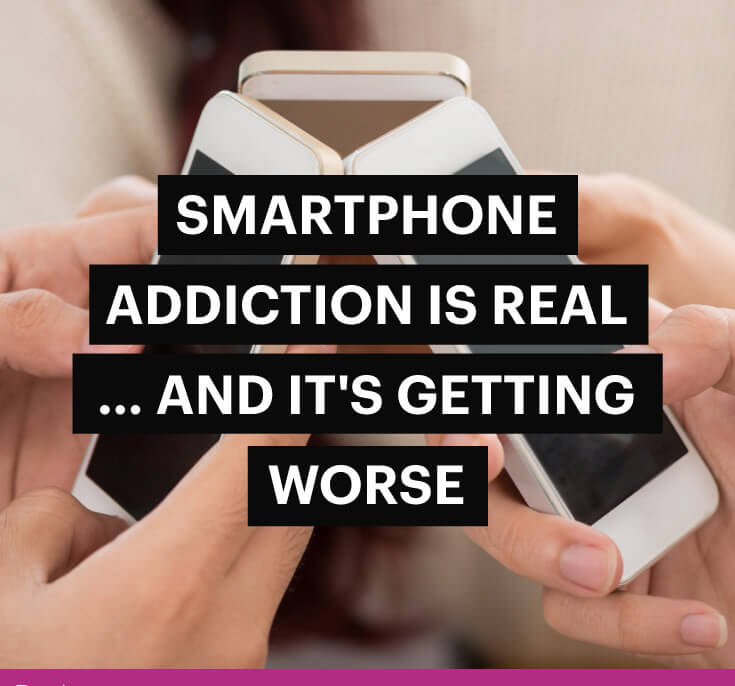Does the “ding” of your phone have you dropping whatever you’re doing to see who “liked” your latest Facebook status?
Are you answering work emails before rubbing the sleep from your eyes?
Does a low battery icon leave you quivering in fear? You, my friend, likely have nomophobia.
Nomowhat?
Nomophobia is the fear of being without your smartphone, or more simply smartphone addiction, and it’s a “first world problem” that’s showing no signs of slowing down, regardless of age.
And while it might sound silly — can you be addicted to a handheld device? — the implications are real.
About half of U.S. adults are checking their phones at least several times an hour, with 11 percent tapping their screen awake every few minutes.
No space is safe from the rush of a new tweet, either.
Almost 1 in 10 Americans have admitted to using their phone during sex.
And among young adults ages 18 to 34, the number is even higher: 1 in 5 has engaged with their smartphone when they’re in between the sheets.
Is it a surprise, then, that 12 percent think that smartphones are detrimental to relationships?
When you combine nomophobia with cars, things get even scarier.
Among American adult drivers, more than 27 percent have sent or read a text while driving. Among young adults, that number shoots up to 34 percent.
What’s the harm in interacting with your phone at a red light or when traffic is heavy? Consider the fact that text messaging while driving makes a crash 23 times more likely. This is Nomophobia.
Yikes.
The Damage Nomophobia Does
Even for those of us who don’t text and drive, nomophobia has serious consequences.
1. You’re wasting time
While many of us are convinced that multitasking allows us to get more done, the answer is multitasking doesn’t work.
Not only are our brains not equipped to handle two different tasks at once, but trying to accomplish several things at once ends up wasting more time than saving any.
Think about it: How well do you retain information when someone’s talking to you as you’re scrolling through emails or watching the latest cat video your friend posted?
Even if your body is in a room, it’s easy to miss important information when your brain is somewhere else entirely.
Plus, let’s face it: No one likes talking to someone who’s “listening” with their face buried in a screen.
2. You’re more anxious
Not having your phone around can increase anxiety.
One British study found that 51 percent of participants suffer “extreme tech anxiety” when separated from their smartphones.
Some of that stems from feeling that, if we’re apart from our phones, we won’t be included when friends make plans or won’t know what the latest Facebook meme is.
Even our bodies are starting to recognize when our phones aren’t around.
A University of Missouri study discovered that iPhone user who parted with their devices during situations that require a significant amount of attention,
taking a test or completing a work assignment could result in more reduced performance.
That’s because, when participants were separated from their phones and then asked to complete simple word search puzzles, their heart rates, and blood pressure increased — as did their feelings of anxiety and unpleasantness.
3. You’re not sleeping as well
“Check email one last time, make sure no friends posted anything interesting, one last glance of Instagram … oh wait, a new work email came in.
Darn it, that afternoon meeting got pushed up.
Did I prep enough for it? Should I review things one more time? Wait, it’s late already. I guess I’ll just think about it for the next half-hour while I toss and turn, trying to fall asleep.”
Sound familiar? Being inundated with stimulating information right before bed often means you can’t sleep well, particularly when we’re presented with situations beyond our control. And most of us are sleeping with our phones.
In almost every age group, at least 40 percent of Americans sleep with their phone within reach. For those 25 to 29 years old, the number’s even higher: almost 80 percent are snuggling up to their device.
The danger isn’t only that each beep overnight has the potential to wake us up.
Smartphones also emit “blue” light, signaling to our brain that it’s time to wake up.
Blue lights suppress melatonin, the hormone that dictates our sleep rhythms. Yes, the struggle to sleep with your phone is real.
4. Your kids are picking up your naughty habits
“Do as I say, not as I do” is all too real when it comes to smartphone time.
Even as parents ask kids and teens to lay off Snapchat or put their phones down during dinner, they’re checking calendars, answering texts, or indulging in one last game of Candy Crush.
It stands to reason that, in almost every study of smartphone use, young adults the highest usage rates.
Children are learning that always being connected is healthy — and missing out on the importance of human-to-human interaction.
Signs You’re Addicted to Your Smartphone
Sure, some people with no self-control might be addicted to their smartphones.
But are you one of them? If any of these apply to you, all signs point to addiction.
- You reach for your smartphone upon waking up and right before bed.
- It’s not uncommon for you to catch up on emails or the latest in the news while you’re eating.
- When your phone is out of reach, low on battery, or (gasp) completely turned off; you feel anxious or stressed out.
- Being out of a cell phone signal makes you feel like you might be missing something.
- You live for that next Instagrammable moment.
- Pavlov’s dogs have nothing on you: When you hear that familiar text-sound, you perk up.
- You’ve checked your phone at least once while reading this article!
Yup. I thought so! It’s ok, though. We’re all in this together.
5-Step Plan to Ending Your Smartphone Addiction
Now that we’ve conquered the first step, admitting there’s a problem, it’s time to fight this thing.
Follow these steps to enjoy a life that’s complemented, not ruled, by your smartphone.
1. Turn off your cell phone at least an hour before bed
Give your brain a chance to unwind and commit to turning off your phone an hour before bedtime. That means off, not just on silent.
Those vibrations and blinking lights are still harmful, as is knowing that you’re only one reach away from seeing the latest.
Remember, nomophobia never sleeps, and neither will you. No wonder, so many of us are always tired, huh?
If you have a legitimate reason for keeping your phone on — your daughter is out with friends, or your parents are elderly, and you don’t have a landline — turn your phone on “do not disturb” and place your phone on the other side of the room.
In this mode, your phone will silence all notifications, but allow you to enable exceptions, such as a phone call from a specific number.
Remember: Seeing how many “likes” your last Instagram post received is not a legitimate reason.
“But I use my phone as my alarm clock,” you say. “I need it nearby!” To that, I respond….
2. Stop shacking up with your phone
Get a real alarm clock (yes, you can still find these Stone Age relics).
Not only will this allow you to turn off your phone entirely overnight (again unless you need to stay on alert for a family member and don’t have a landline),
but instead of waking up with the temptation to see what you missed overnight, you can spend the first moments of the morning stretching,
thinking about what’s on schedule for the day or doing anything other than checking your phone.
For extra credit, I challenge you not to turn your phone on again until your morning routine is finished:
you’ve showered, dressed, eaten breakfast, maybe even read the paper (remember that pastime!) and pushed the kids out the door.
3. Set specific times to check your phone
Do you need to look at every single email the second it’s received?
Save your sanity and simultaneously help your productivity by designating specific times to glance at your smartphone.
For instance, you might want to do a five-minute sweep of your social networks and email right before sitting down at your desk to do work,
then hide your phone away for the next hour when you take a five-minute break.
Structuring your working hours around short breaks helps you settle into your task without distractions for some time while knowing that a “break” is just around the corner.
Additionally, once the workday is over, give yourself a set length of time that you’re allowed to check anything work-related.
Maybe after dinner (and well before bedtime!), you allow yourself 10 minutes to review any messages that might have come in or need your attention.
And this is the time to be discerning:
If it’s not something that requires your attention right this second (i.e., a million-dollar deal will fall through if you don’t answer that email), it can wait until morning.
4. Establish phone-free zones
I know I can’t be the only one who’s horrified that smartphones are disrupting people during intimate moments.
With that said, designating certain places and times as phone-free zones is a great way to tackle nomophobia.
Mealtimes are an excellent place to start: Instead of scrolling and chewing, you can practice mindful eating and engaging conversation.
It’s also a prime opportunity to set an example for kids; they’ll see you value conversation and good food over responding to your phone’s every ring.
And please, just say no to phones in bed.
5. Engage in real human contact
Finally, instead of “connecting” with friends and family over social media, try spending some real-time with them and get rid of Nomophobia.
Instead of “liking” your cousin’s status, call him up to hear the story firsthand (gasp!).
Set up a coffee date to catch up with friends instead of that group text. Send a thoughtful card to a faraway friend.
We’re social creatures who thrive on real human interaction. That’s something a smartphone just can’t replicate.








